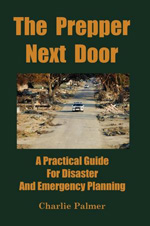There’s one item we haven’t covered: The bag itself. How are we going to carry all this crap?
When it comes to packing you’ll have two issues. Weight and bulk. Keep the weight as close to your back as possible and below shoulder height. Keep the load evenly balanced. Bulk can be carried anywhere. It looks oppressive, but a huge sleeping pad rolled up can sit at the top or strapped to the back of the pack. Heavier bulky items, tent, should be lower or closer to your body.
You’ll look like a beast of burden, but you can strap a duffel bag to the back of your pack as long as it contains relatively light weight clothing. You won’t be shimmying between rocks in a cave and you could get blown off a real mountain with such a contraption. On a typical road, you’ll be fine.
I recommend owning a good quality backpack. If you have cold weather survival clothing, I recommend you keep it in a large duffel bag. If forced to flee your home, you can grab your pack and your duffel and change into your best clothing at some point. Boots can be in your duffel, if you want.
As I recommend in the book, you can assemble another duffel bag with heavy-duty camping gear. You’d never carry this on your back, but if you bug out by vehicle and it is a the-world-is-totally-ending-and-I’m-out-of-here-and-never-coming-back scenario, you’d have a collection of some of the best equipment in the world to survive in the wild. Carry it as far as you can by vehicle, stash it, and hope you can recover it later. If you have a BOL with shelter, you’d keep this stuff there.
Some stuff to consider for this end-of-the-world duffel/BOL:
Heavy Cooking Grill
Dutch Oven
Heavy Duty Cook Set
Rope
Snare Wire
Fishing Gear
Ax
Loppers
Bow Saw & Blades
Rifle & Extra Ammo
In another duffel, you could keep a larger tent. Alaskatent.com. You could live in it until you were able to build a better home. Not carried on your back.
I violate a rule of BOBs that says everything must be packed at ready to go. I keep sleeping bags hanging in a closet. I think they keep loft better this way than being all munched up. I’d need to grab the right ones for the right season on my way out the door and pack them quickly. Yes, if my home burned down before I got to them I’d be SOL.
The best backpacks today are internal framed expedition packs. They have solid belts to secure the pack about the hip. An external framed pack can work too. Some preppers like to stick with surplus military gear. The only downside to expedition packs is the expense.
Three good places to search for packs & sleeping bags and other stuff:
TheNorthFace.com
EMS.com
REI.com
You can order packs over the Internet but it’s much better if you have a local store to try them on. You want one that fits and is comfortable for you.
The trend today is to carry water in hydration bladders. They provide the lightest weight container for the most water. I don’t like and trust bladders. A cheap and workable alternative is two 2 Liter bottles to supplement your regular water bottle. Used Pepsi bottles work fine. They seal tightly and won’t leak.
Most bug outs won’t last forever. The final class of items to add are your important records and papers. Information identifying who you are, your insurance information, checkbook, important records.
Learning More:
For learning more about outdoor survival, two books I like are How To Stay Alive In The Woods By Bradford Angier and Survival With Style by Angier. I’d guess there are better books today but I’m not familiar with them. I’d suggest you get some books about backpacking. They can provide you with a ton of information. Get out and go hiking!
Charlie Palmer -author The Prepper Next Door
***
What Are Your Top 3 Prepping Items?
My answer: 1) Water; 2) Food; 3) Gun & Ammo; 4) Good Warm Clothing
Outdoor answer: 1) Knife; 2) Cook kit; 3) Good Warm Clothing; 4) Fire starter
Can you live without a refrigerator? (My answer: No! Little known fact: Even cavemen had fridges …without refrigeration we all die immediately!)
I like the point about looking to RVers and self-sufficient sailors. They have great information.
One tip: Cold air sinks. Most fridges open and the cold air pours out. Small boats have boxes which open at the top. The cold air stays in when it’s opened.
Refrigeration is a pain because of how much energy it takes.
**
Good article about what goes through your mind if your home is in the path of a raging fire.
“I arrived at our house, the evacuation order was already in place, and I had about an hour to pack up the essentials. ”
